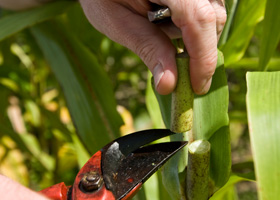Pearl Millet
- Over 29 million hectares of Pearl millet is cultivated in about 30 countries of Asia and Africa.
- Pearl Millet has high levels of tolerance to high temperatures and drought and adaptation to poor soil fertility and degraded lands.
- Research has shown some genotypes well adopted to soil salinity levels as high as 15 dsm-1 and some populations with an average dry matter production of 15-25 t/ha under various salinity levels.
Description
Pearl millet is cultivated in about 30 countries of Asia and Africa over 29 million ha of which 11.5 m ha is in Asia, with India accounting for 32% (9.3m ha) of the total world area. Productivity of pearl millet ranges from 0.6 to 1.0 t ha-1 (ICRISAT, 2008). Production of pearl millet in India has been reported to be 9.5 m t with a productivity of 1.04 t ha-1(Yadav et al., 2010). This crop has evolved into diverse range of ecotypes with high levels of tolerance to high temperatures and drought and adaptation to poor soil fertility and degraded lands, including those affected by soil salinity. Recent research has shown large genetic variations for salinity tolerance with some of the populations and genotypes well adopted to soil salinity levels as high as 15 dsm-1 and some populations of pearl millet have been identified with an average dry matter production of 15-25 t ha-1and green matter production from 45 to 80 t ha-1 under various salinity levels (Rai et al., 2010). Though, research on ethanol production from pearl millet has not received enough attention up till now, but the presence of high biomass coupled with its ethanol-friendly characters ensures high possibility of this crop becoming future bio-fuel crop of the marginal lands of semi-arid tropics. The yield levels of improved open pollinated varieties (OPV) can be further enhanced by integrating with improved cultural practices. Pearl millet is tolerant against most insects, fungi and adverse weather conditions which has always been a major obstacle for the production of bio-fuel crops rich in lignocelluloses. Moreover, very low rainfall requirement (less than 300 mm) and minimum nitrogen requirement compared to most of the other cereal crops qualifies them as a prime candidate for biomass production.
Pearl Millet

Cutting a sample of sorghum for test purposes. Sorghum crops, biofuel production.